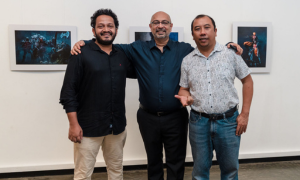
Aug 08 2025.
views 83On the 2nd and 3rd of August, the Harold Peiris Gallery in Colombo 7 hosted Excelsior, Sri
Lanka’s first-ever photographic exhibition dedicated to pop culture archetypes. Curated and created by a group of local collectors, geeks, and photographers, Excelsior, contrary to the usual fare served up at local exhibitions, featured neither landscapes nor heritage ruins nor wildlife. It turned its lens on superheroes and fantasy icons, not through the usual fan art or cosplay, but through meticulously staged and photographed collectable statues and figurines that blurred the line between fiction and memory.

Given that the exhibition’s title was a nod to Stan Lee’s iconic sign-off, “Excelsior!”, it came as little surprise that characters like Superman, He-Man, The Phantom, and Wolverine made an appearance. So too did heroes and anti-heroes drawn from the rich and often darker worlds of 70s, 80s, and 90s pop culture.
But the heart of Excelsior was not in who was featured, but why. This was not a commercial exhibition—entry was free—nor was it a fan expo. Rather, it was a heartfelt labour of love, born from memory, passion, and cultural commentary. The project was spearheaded by Sri Lankan collectors and enthusiasts Aman Ashraff, Tai Hsin Shiek, and Ushan Gunasekera, whose childhoods were shaped by comic books in a pre-digital era. Post-production was led by Sanjaya Kumar, who transformed their raw captures into dramatic visual narratives.
The result was a compelling visual record of a generation raised on stories of courage, justice, and sacrifice, not through textbooks, but through pop culture archetypes. These masked vigilantes, misunderstood mutants, and reluctant leaders shaped the moral imagination of children who grew up without algorithms or endless content. Often reading incomplete comics and relying on pure imagination to fill the gaps, this generation created meaning through memory and play.
The creators of Excelsior all belong to a generation that grew up in the 1980s and 90s, a time when hobbies were not fleeting distractions but identity-defining practices. Whether it was collecting stamps or Dinky Toys, trading comic books, or assembling model planes, these were acts of devotion, discipline and care. You waited months for a new issue. You saved your pocket money to buy a miniature car. You did not collect because it was cool. You collected because it meant something.
For those who visited, Excelsior offered more than nostalgia. Visitors saw how a simple object, such as a statue or a figurine, could, in the right hands, become a work of emotional and cultural art. They were surprised by how much power lived in stillness, and how much storytelling could exist in a single frame. And maybe, just maybe, some walked out remembering the version of themselves who once wore a cape, carried a lightsaber, or stood a little taller because they believed in something greater than us all.
0 Comments